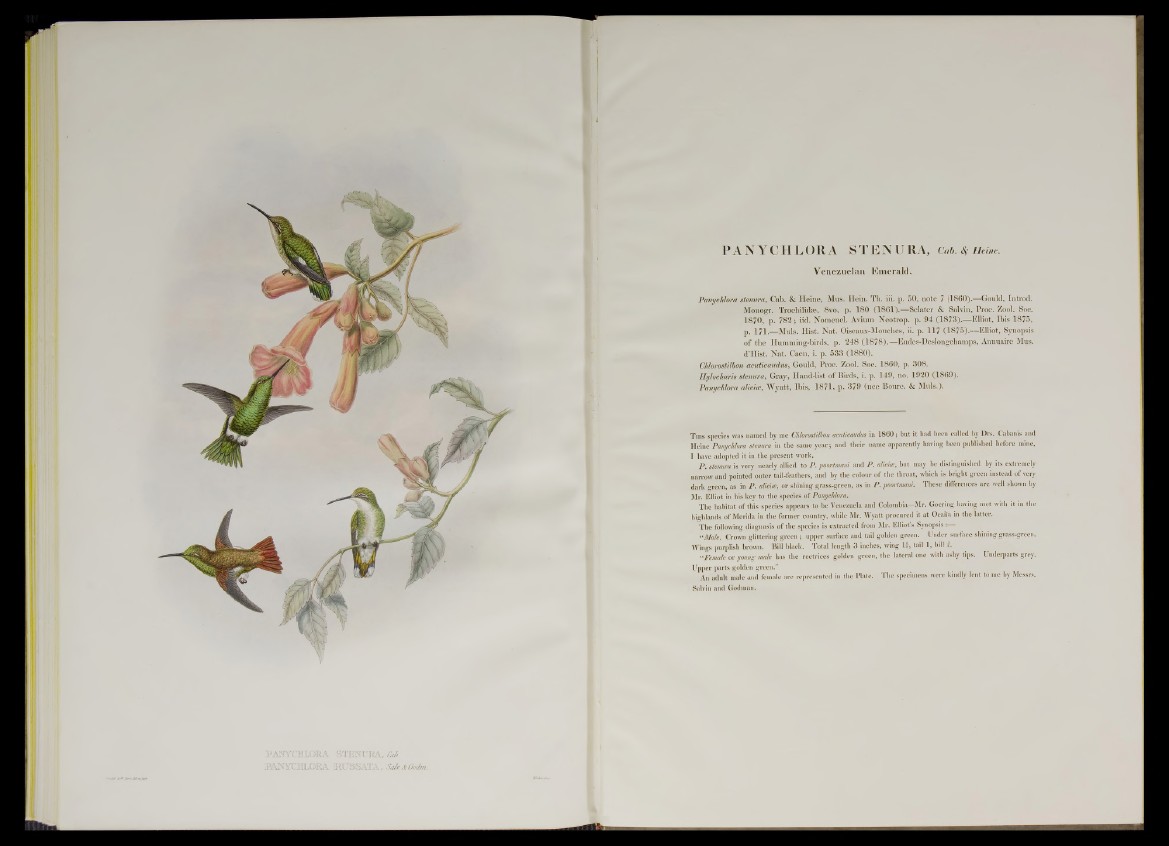
PANYCHIOEA STENURA, Cab,
jRANYCÏÏLXÏRA IRUSSATA, Salv & ùodrru
PANYCHLORA STENURA, Cab. $ Heine.
Venezuelan Emerald.
Panyclilora stenura, Cab. & H e in e , Mus. H ein. Th. iii. p. 50 , n o te 7 (1 8 6 0 ).— Gould, Introd.
Monogr. Trochilidæ, 8 vo, p. 1 8 0 (1 8 6 1 ).— Sclater & Salvin, Proc. Zool. Soc.
1 8 7 0 , p. 7 8 2 ; iid. N om en c l. Avium Neotrop. p. 9 4 (1 8 7 3 ) .— Ellio t, Ibis 1 8 7 5 ,
p. 1 7 1 .— Muls. H ist. N a t. Oiseaux-Mouches, ii. p. 1 1 7 (1 8 7 5 ).— Elliot, Synopsis
o f th e Humming-birds, p. 2 4 8 ( 1 8 7 8 ) .— Eu des-Deslongchamps, Annuaire Mus.
d’H ist. N a t. Caen, i. p. 5 3 3 (1 8 8 0 ).
Chlorostilbon acuticaudus, Gould, Proc. Zool. Soc. 1 8 6 0 , p. 3 0 8 .
E y lo ch a ris stenura, Gray, Ilan d -list o f Birds, i. p. 1 4 9 , no. 1 9 2 0 (1 8 6 9 ).
Panyclilora alicice, W y a tt, Ibis, 1 8 7 1 , p. 3 7 9 (n e c Bourc. & Muls.).
T his species was named by me Chlorostilbon acuticaudus in 1860; but it had been called by Drs. Cabanis and
Heine Panyclilora stenura in the same year; aud their name apparently having been published before mine,
I have adopted it in the present work.
P . stenura is very nearly allied to P . poortmani and P . alicice, but may be distinguished by its extremely
narrow and pointed outer tail-feathers, and by the colonr of the throat, which is bright green instead o f very
dark green, as in P . alicice, or shining grass-green, as in P . poortmani. These differences are well shown by
Mr. Elliot in his key to the species o f Panychlora.
The habitat o f this species appears to be Venezuela and Colombia—Mr. Goering having met with it in the
highlands o f Merida in the former country, while Mr. Wyatt procured it at Ocana in the latter.
The following diagnosis o f the species is extracted from Mr. Elliot’s Synopsis:
“Male. Crown glittering green ; upper surface and tail golden green. Under surface shining grass-green.
Wings purplish brown. Bill black. Total length 3 inches, wing If, tail 1, hill i .
“Female or young male has the rectrices golden green, the lateral one with ashy tips. Underparts grey.
Upper parts golden green.”
An adult male and female are represented in the Plate. The specimens were kindly lent to me by Messrs.
Salvin and Godman.